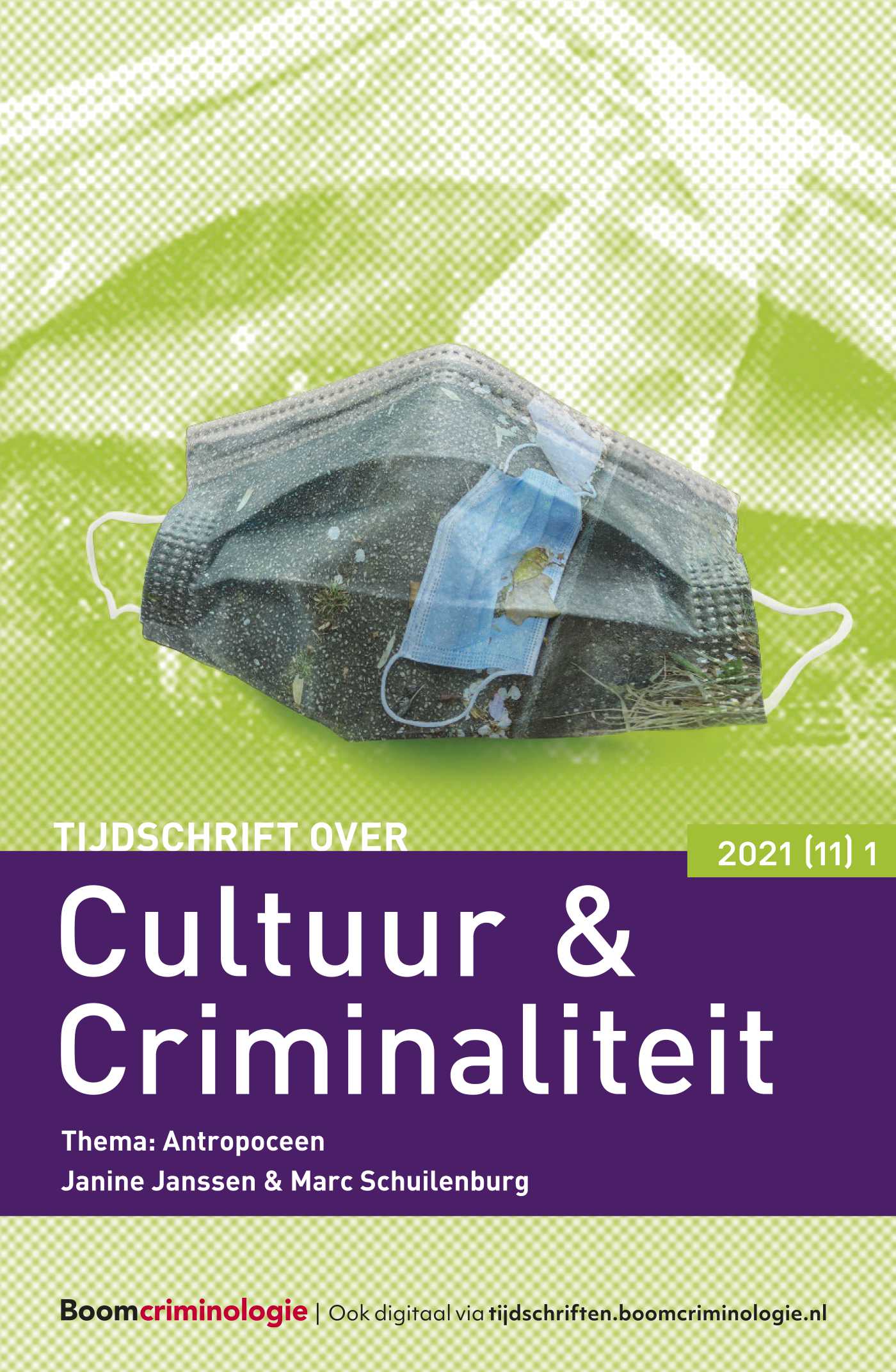|
Cultural criminology has shown an interest in the visual representation of perpetrators, victims and scenes of crime and punishment in the media. Relatively little attention has been paid to the visual representation of these subjects in the fine arts, however. This lacuna has been the inspiration for this special issue about the art of representation and the relationship between fine arts and criminology. Questions that are addressed include: What is the importance and meaning of representational art for the criminologist? It is conceivable that a criminological researcher would reformulate his or her research problem due to insights that have been articulated by artists? And, by the same token, is it possible that an artist would revise his or her representation because of scientific research? Or, are the doings of both independent of one another? Ultimately, this special issue is concerned with how representations of perpetrators, victims and scenes of crime and punishment come into being, which meaning these images have in different social and cultural contexts and what we, as criminologists, can contribute to them. |


Tijdschrift over Cultuur & Criminaliteit
Meer op het gebied van Criminologie en veiligheid
Over dit tijdschriftMeld u zich hier aan voor de attendering op dit tijdschrift zodat u direct een mail ontvangt als er een nieuw digitaal nummer is verschenen en u de artikelen online kunt lezen.
| Artikel |
De kunst van het verbeeldenOver de relatie tussen beeldende kunst en criminologie |
| Trefwoorden | visual criminology, fine arts, representation |
| Auteurs | prof. dr. Willem de Haan en prof. dr. René van Swaaningen |
| SamenvattingAuteursinformatie |
| Artikel |
Hunting Worlds Turned Upside DownPaulus Potter’s Life of a Hunter |
| Trefwoorden | Art, green criminology, non-speciesism, human-animal relationships |
| Auteurs | prof. dr. Piers Beirne en dr. Janine Janssen |
| SamenvattingAuteursinformatie |
|
Life of a Hunter (c.1647) is an extraordinary painting by the young Dutch artist Paulus Potter. Its fourteen panels tell the tale of a well-heeled gentleman who likes to hunt and to kill “game” and “exotic” animals. The hunting world is turned upside down when the animals capture the hunter and put him on trial. He is condemned to death, roasted alive and doubtless consumed by the very creatures who had earlier been his quarry. In this essay we try to interpret Potter’s painting. Is it an allegory of the chaotic politics of the mid-17th century Dutch Republic? Does it represent an early modern animal trial? Our tentative conclusion is that Life of a Hunter expresses a Montaignian-inspired moment of transition in cultural attitudes towards human-animal relationships: its restricted vision of animal cruelty is not against animal cruelty tout court and its inversion of two links in the great chain of being is very far from being altogether pro-animal. |
| Artikel |
Vagebonden in woorden en daden, én in beeldenVan deerniswekkende drommel via vrijheidslievende romanticus tot zorgwekkende zorgmijder |
| Trefwoorden | Beggars, Tramps, Vagrancy, Vagabonds, visual arts |
| Auteurs | prof. dr. Frans Koenraadt |
| SamenvattingAuteursinformatie |
|
Vagabonds, mainly relating to beggars and vagrants, have occupied the Western European social and criminal landscape by the ages. In this contribution some long term patterns – from the Middle Ages onwards – are investigated. The central questions are a) What is the place vagabonds occupied in society? and b) How was dealt with them in the past centuries? In order to answer these questions the perception of and the distinction between true and false beggars and vagrants are included. In addition to penal and criminological sources also those from the visual arts (history) are applied. Answering these questions shows a process of increasing institutionalization seeing a pattern of social exclusion to institutional confinement. An important role in the institutionalization is reserved for the interference of criminal law. |
| Artikel |
GezichtsbedrogOver de verbeelding van kleptomanie |
| Trefwoorden | Marlene Dumas, Géricault, kleptomania, ethics of representation |
| Auteurs | prof. dr. Willem de Haan |
| SamenvattingAuteursinformatie |
|
An analysis is made of how the painting The Kleptomaniac (2005) by Marlene Dumas – especially through its title – represents a certain kind of criminal and what ethical implications this has. A discussion of art historical research on the genesis of the original Portrait of a kleptomaniac (ca. 1820) from which Dumas has taken the title for her painting, is followed by a discussion of the history of the concept of kleptomania in psychiatry and an analysis of how that concept is reproduced by Dumas’ painting and, in particular, its title: The Kleptomaniac. By giving a painting of a male face this title in 2005 a type of criminal is represented in a way that does not do justice to the history of the concept and the phenomenon itself. By mobilizing a contested and obsolete psychiatric concept for an artistic project, the ambiguity which the painter intended is not left intact but, in fact, destroyed by an allusive title which mystifies the subject while having a disorienting effect on the viewer of the painting. |
| Artikel |
From graffiti to pixaçãoUrban protest in Brazil |
| Trefwoorden | Brazilian graffiti, pichação, pixação, criminalization, resistance |
| Auteurs | Paula Gil Larruscahim |
| SamenvattingAuteursinformatie |
|
This paper explores the hypothesis that the process of rupture in Brazilian graffiti writer’s subculture resulting in different groups - pichadores, pixadores and grafiteiros - took place in two different, though complementary, stages. The first stage is the commodification of graffiti by successive media campaigns and its penal control by the state. The second stage - which may be considered as a side effect of the first one - consists of the emergence of a new transgressive pixação movement. Instead of merely writing or tagging their signatures and messages on the walls of the city, they claim the freedom of usage of the urban space and contest the importance that property has in the late modernity context. |
| Artikel |
|
| Trefwoorden | Constantijn Kelk, Constant Nieuwenhuys, compassion, solidarity |
| Auteurs | prof. dr. Willem de Haan |
| Samenvatting |
|
In this interview, Contantijn Kelk talks about his life and career in criminal law and the relationship between his work and the fine arts. More specifically, he talks about his friendship with the painter Constant Nieuwenhuys (1920-2005) who, like he himself, in his work demonstrated compassion and solidarity with the suspected, convicted and detained fellow human being. |
| Boekbespreking |
Criminaliteit en kunstBetekenisgeving aan verbeeldingen |
| Trefwoorden | art, exhibition, visual criminology, construction of meaning |
| Auteurs | dr. Gabry Vanderveen |
| SamenvattingAuteursinformatie |
|
The recent exhibition The Crime Was Almost Perfect in the Witte de With Center for Contemporary Art in Rotterdam, curated by Cristina Ricupero, focused on the dynamic relation between art (aesthetics) and crime (ethics). The review discusses the representations of crime in (some of) the exhibited art works and analyzes the ways in which the artists play with their (conflicting) meanings, ambivalences and ambiguities. |
| Praktijk |
De collectie van Lombroso |

